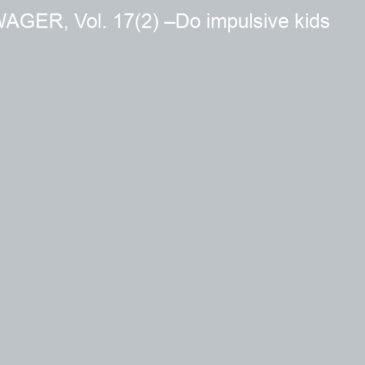Research suggests that the development of gambling problems is associated with other impulsive behaviors and might relate to underlying impulse control deficits (Carlton and Manowitz 1992; Leeman and Potenza 2012). However, most of this research is cross-sectional and relies on retrospective reporting. This week, the WAGER reviews a longitudinal study that investigated how childhood impulsivity relates to gambling problems in adulthood (Shenassa, Paradis et al. 2012).
Methods
- The study cohort originated from the Collaborative Perinatal Project (CPP), a pre- to postnatal study of expectant mothers and their offspring investigating the causes of neurological defects. (N = 15,721 Mother/Child pairs, recruitment from 1959-1966)
- The cohort was selected from the subset of offspring who also participated in a follow-up study about tobacco use (N = 1674) and had complete childhood behavior data and follow-up gambling data (final cohort N = 958).
- The researchers derived impulsivity and shyness/depression scales by coding psychologists’ interviews with the children at age 7 (Kubzansky, Martin et al. 2009). These scales were dichotomized: children who were rated as exhibiting any impulsive behaviors were classified as impulsive; children in the top 10% of the shyness/depression scale were classified as shy/depressed.
- As part of a follow-up conducted 40 years after the beginning of the study (Mean age = 39.2 SD = 1.8), researchers assessed gambling problems via the South Oaks Gambling Screen (SOGS) (Lesieur and Blume 1987), classifying participants with SOGS scores of 3 or greater as problem gamblers.
- The researchers used multivariable modeling techniques to examine how impulsive and shy/depressed behavior at age 7 predicted problem gambling in adulthood.
Table 1. Adjusted associations between age 7 behavior problems and life-time problem gambling (adapted from Shenassa, Paradis et al. 2012)
|
|
Adjusted odds ratios (95% confidence intervals) for life-time problem gambling |
||
|
Characteristic |
Model 1 |
Model 2 |
Model 3 |
|
Age 7 Impulsive |
3.24 (1.47-7.14)* |
|
3.09 (1.40-6.82)* |
|
Age 7 Shy/depressed |
|
2.30 (0.97-5.44) |
2.08 (0.87-4.99) |
*p<.05
Note. All models included the following variables as controls: demographic factors, childhood IQ, and study site.
Results
- Participants who were impulsive at age 7 were over 3 times more likely to be problem gamblers later in life.
- Shyness/depression, though associated with problem gambling in univariate models, did not predict problem gambling when demographic variables were controlled and did not affect the relationship between impulsivity and problem gambling.
Limitations
- The childhood assessment took place over a 2-hour session and thus, might not reflect the child’s actual impulsive or shy/depressed behavior.
- The study sample might not be representative of the population because participants were selected based on inclusion criteria for tobacco-related follow-up studies.
Conclusions
The findings suggest that children exhibiting impulsive behavior might be at higher risk of problem gambling during adulthood, suggesting that middle childhood impulsivity might be an important early target for prevention programs. Future research ought to investigate whether the influence of impulsivity is specific to gambling problems in this population or holds for other addiction-related behaviors.
-Jed Jeng
What do you think? Please use the comment link below to provide feedback on this article.
References
Carlton, P. L., & Manowitz, P. (1992). Behavioral restraint and symptoms of attention deficit disorder in alcoholics and pathological gamblers. Neuropsychobiology, 25, 44-48.
Kubzansky, L. D., Martin, L. T., & Buka, S. L. (2009). Early manifestations of personality and adult health: a life course perspective. Health Psychol, 28(3), 364-372.
Leeman, R. F., & Potenza, M. N. (2012). Similarities and differences between pathological gambling and substance use disorders: a focus on impulsivity and compulsivity. Psychopharmacology (Berl), 219(2), 469-490.
Lesieur, H. R., & Blume, S. B. (1987). The South Oaks Gambling Screen (SOGS): A new instrument for the identification of pathological gamblers. American Journal of Psychiatry, 144(9), 1184-1188.
Shenassa, E. D., Paradis, A. D., Dolan, S. L., Wilhelm, C. S., & Buka, S. L. (2012). Childhood impulsive behavior and problem gambling by adulthood: a 30-year prospective community-based study. Addiction, 107(1), 160-168.




